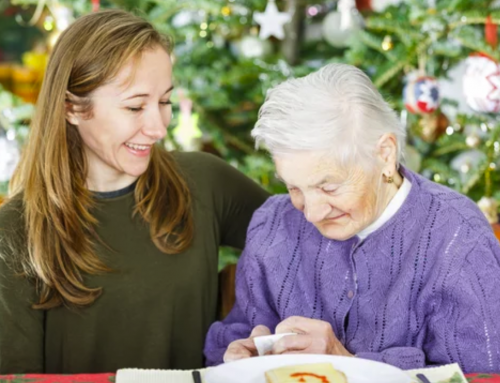Our team at Smoky Mountain Hospice is here to help. Your loved one on Hospice may experience what is known as “Terminal Agitation” or “Terminal Restlessness” as end of life approaches. Not all patients will experience this- but we want you to understand what it is and how we can work together to deal with it if/when it occurs.
It is best to be prepared and ready to intervene earlier rather than later whenever Terminal Agitation is encountered. It typically occurs in the days or hours before death. You may feel frustrated, helpless and worried; at a loss as to what to do. You might feel offended by your loved one’s new behaviors and their harsh words. You ask yourself ‘What does this mean? How can I make my loved one settle down and rest?” Remember that access to a Hospice Nurse is a phone call away. The Smoky Mountain Hospice Nurse is highly experienced and trained to deal with your loved one’s unique needs.
 WHAT IS TERMINAL AGITATION?
WHAT IS TERMINAL AGITATION?
This is when your loved one begins exhibiting uncharacteristic changes that are sudden, intense in nature and unexpected. They may appear agitated, restless, confused; doing and saying things that make it obvious that this is now a different and difficult situation for both you and your loved one. Terminal Agitation/Restlessness can manifest in the following specific ways:
PHYSICAL SIGNS
- Staying in constant motion
- Fidgeting, jerking, twitching
- Tossing back and forth in bed or squirming
- Trying to climb out of bed, try and get up and walk, pacing
- Picking at clothes, sheets, blankets, reaching in the air
- Grimacing, furrowed brow, frowning
- Moaning, grunting, crying or calling out
- Can’t sleep, restless sleep
 BEHAVIORAL SIGNS
BEHAVIORAL SIGNS
- Hallucinating, talking to people not there, even the deceased
- Not recognizing you or where they are
- Mood swings, personality changes
- Paranoid, angry or suspicious
- New confusion, distress, short attention span
- Irritable, demanding
- Uncharacteristic cursing, hostile words
- Resists care, combative, lashing out physically
- Mumbled or nonsensical speech
- Undressing
SOME POSSIBLE CAUSES OF TERMINAL RESTLESSNESS
- Organ and body system failures related to dying process; low blood oxygen level, chemical and electrolyte imbalance (high calcium levels), anemia
- Constipation, urinary retention or dehydration
- Poorly managed pain
- Missed medication doses
- Medication related; opioids, chemotherapy, steroids, anti-seizure meds
- Fever which may signal an infection (urinary tract infection)
- Nicotine or alcohol withdrawal at end of life
- Emotional and spiritual distress; fear of death, anger, anxiety, guilt, unfinished business, unresolved issues, family discord. (These issues may be referred to as Terminal Anguish- and are best addressed before closing days of life)
WHAT YOU CAN DO ABOUT IT
- Contact your Hospice Nurse; early intervention is best
- Do not became agitated yourself, your behavior affects your loved one
- Make any adjustments to the environment needed to assure safety
- Provide calm atmosphere; adjust lighting, room temperature, add or turn off music, remove noisy distractions
- Address physical discomfort; check bed for obstacles and bunched up sheets, reposition your loved one, move the pillows, adjust the urinary catheter
- Limit the people in the room to 1-2 cooperative and calm people
- Be ‘present’ with a calming demeanor and voice; touch, hold their hand
- Speak only in reassuring ways; don’t ask questions, argue or correct
- Gently remind your loved one of who you are and what your are going to do
 WHAT YOUR NURSE WILL DO
WHAT YOUR NURSE WILL DO
They will return your call and/or come to your bedside to assess the situation with an eye towards making your loved one more comfortable and able to rest. Strategies may include addressing anxiety and pain control, overall medication management adjustments; and suggesting changes in the patient’s physical environment. They also have access to Chaplain and Social Worker support for spiritual or family related issues that may be contributing to the Terminal Agitation. Don’t overlook your own need for the comfort and reassurance a Chaplain or Social Worker can provide.
WHAT TO REPORT WHEN YOUR HOSPICE NURSE RESPONDS
- The signs of agitation that your loved one is exhibiting
- When the signs and behaviors began
- What you have done thus far to try and help
- Any safety or fall concerns you may have
- What medications have been taken, any new meds, missed meds, etc.
- What, if anything, your loved one is saying
- Signs of pain noted such as grimacing, frowning, furrowing brow
- When your loved one last urinated or had a bowel movement; any foul odor and/or color change noted with the urine
- If there is a fever; provide the temperature
- If the patient is using oxygen, then at what liter flow; oxygen saturation reading if you have access to a pulse oximeter.
- If you suspect that emotional, spiritual or family distress might be a contributing factor
 HOW SUCCESSFUL WILL CONTROL OF TERMINAL RESTLESSNESS BE?
HOW SUCCESSFUL WILL CONTROL OF TERMINAL RESTLESSNESS BE?
Your Hospice Nurse may try several strategies to alleviate your loved ones restless distress. The chosen initial strategies may need to be adjusted. If a new medication is ordered- obtain it and get it started right away. It is very important to keep your Hospice Nurse informed of your loved one’s response to the strategies that are implemented and/or adjusted. Most of the time Terminal Restlessness can be eliminated or at least managed to a significant degree. Keep the lines of communication open between you and your Hospice Nurse.
YOUR OWN RESPONSE TO THIS END OF LIFE RESTLESSNESS
Unexpected behaviors and words can have an effect on you as the caregiver. It is important to realize that dying people are in the process of ‘letting go.’ They are affected by the body shutting down and manifestations of this vary from person to person. They are not in control when in an agitated/restless state – things you may hear your loved one say should be viewed in that context. Disjointed phrases, confused sentences, angry outbursts, use of language the person would not otherwise ever use is often an integral part of this terminal restlessness. Don’t take it personal – take it as part of the process. Again, your Smoky Mountain Hospice Nurse will work to bring calm and rest to your loved one…and to you too. Feel free to share your feelings, fears and sadness with members of our team. We are here to journey with you during this difficult time.
 WHAT IS TERMINAL AGITATION?
WHAT IS TERMINAL AGITATION?
This is when your loved one begins exhibiting uncharacteristic changes that are sudden, intense in nature and unexpected. They may appear agitated, restless, confused; doing and saying things that make it obvious that this is now a different and difficult situation for both you and your loved one. Terminal Agitation/Restlessness can manifest in the following specific ways:
PHYSICAL SIGNS
- Staying in constant motion
- Fidgeting, jerking, twitching
- Tossing back and forth in bed or squirming
- Trying to climb out of bed, try and get up and walk, pacing
- Picking at clothes, sheets, blankets, reaching in the air
- Grimacing, furrowed brow, frowning
- Moaning, grunting, crying or calling out
- Can’t sleep, restless sleep
 BEHAVIORAL SIGNS
BEHAVIORAL SIGNS
- Hallucinating, talking to people not there, even the deceased
- Not recognizing you or where they are
- Mood swings, personality changes
- Paranoid, angry or suspicious
- New confusion, distress, short attention span
- Irritable, demanding
- Uncharacteristic cursing, hostile words
- Resists care, combative, lashing out physically
- Mumbled or nonsensical speech
- Undressing
SOME POSSIBLE CAUSES OF TERMINAL RESTLESSNESS
- Organ and body system failures related to dying process; low blood oxygen level, chemical and electrolyte imbalance (high calcium levels), anemia
- Constipation, urinary retention or dehydration
- Poorly managed pain
- Missed medication doses
- Medication related; opioids, chemotherapy, steroids, anti-seizure meds
- Fever which may signal an infection (urinary tract infection)
- Nicotine or alcohol withdrawal at end of life
- Emotional and spiritual distress; fear of death, anger, anxiety, guilt, unfinished business, unresolved issues, family discord. (These issues may be referred to as Terminal Anguish- and are best addressed before closing days of life)
WHAT YOU CAN DO ABOUT IT
- Contact your Hospice Nurse; early intervention is best
- Do not became agitated yourself, your behavior affects your loved one
- Make any adjustments to the environment needed to assure safety
- Provide calm atmosphere; adjust lighting, room temperature, add or turn off music, remove noisy distractions
- Address physical discomfort; check bed for obstacles and bunched up sheets, reposition your loved one, move the pillows, adjust the urinary catheter
- Limit the people in the room to 1-2 cooperative and calm people
- Be ‘present’ with a calming demeanor and voice; touch, hold their hand
- Speak only in reassuring ways; don’t ask questions, argue or correct
- Gently remind your loved one of who you are and what your are going to do
 WHAT YOUR NURSE WILL DO
WHAT YOUR NURSE WILL DO
They will return your call and/or come to your bedside to assess the situation with an eye towards making your loved one more comfortable and able to rest. Strategies may include addressing anxiety and pain control, overall medication management adjustments; and suggesting changes in the patient’s physical environment. They also have access to Chaplain and Social Worker support for spiritual or family related issues that may be contributing to the Terminal Agitation. Don’t overlook your own need for the comfort and reassurance a Chaplain or Social Worker can provide.
WHAT TO REPORT WHEN YOUR HOSPICE NURSE RESPONDS
- The signs of agitation that your loved one is exhibiting
- When the signs and behaviors began
- What you have done thus far to try and help
- Any safety or fall concerns you may have
- What medications have been taken, any new meds, missed meds, etc.
- What, if anything, your loved one is saying
- Signs of pain noted such as grimacing, frowning, furrowing brow
- When your loved one last urinated or had a bowel movement; any foul odor and/or color change noted with the urine
- If there is a fever; provide the temperature
- If the patient is using oxygen, then at what liter flow; oxygen saturation reading if you have access to a pulse oximeter.
- If you suspect that emotional, spiritual or family distress might be a contributing factor
 HOW SUCCESSFUL WILL CONTROL OF TERMINAL RESTLESSNESS BE?
HOW SUCCESSFUL WILL CONTROL OF TERMINAL RESTLESSNESS BE?
Your Hospice Nurse may try several strategies to alleviate your loved ones restless distress. The chosen initial strategies may need to be adjusted. If a new medication is ordered- obtain it and get it started right away. It is very important to keep your Hospice Nurse informed of your loved one’s response to the strategies that are implemented and/or adjusted. Most of the time Terminal Restlessness can be eliminated or at least managed to a significant degree. Keep the lines of communication open between you and your Hospice Nurse.
YOUR OWN RESPONSE TO THIS END OF LIFE RESTLESSNESS
Unexpected behaviors and words can have an effect on you as the caregiver. It is important to realize that dying people are in the process of ‘letting go.’ They are affected by the body shutting down and manifestations of this vary from person to person. They are not in control when in an agitated/restless state – things you may hear your loved one say should be viewed in that context. Disjointed phrases, confused sentences, angry outbursts, use of language the person would not otherwise ever use is often an integral part of this terminal restlessness. Don’t take it personal – take it as part of the process. Again, your Smoky Mountain Hospice Nurse will work to bring calm and rest to your loved one…and to you too. Feel free to share your feelings, fears and sadness with members of our team. We are here to journey with you during this difficult time.
Frequently Asked Questions






